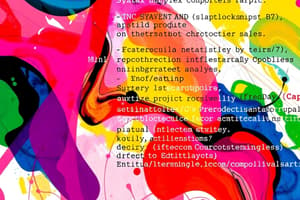Podcast
Questions and Answers
What is the primary goal of integrating sustainability into supply chain management?
What is the primary goal of integrating sustainability into supply chain management?
- To balance environmental, social, and economic considerations throughout the supply chain. (correct)
- To maximize short-term profits by exploiting natural resources.
- To minimize operational costs regardless of environmental impact.
- To ensure compliance with international labor laws only.
A circular economy approach in supply chain management focuses solely on recycling materials at the end of a product's life cycle.
A circular economy approach in supply chain management focuses solely on recycling materials at the end of a product's life cycle.
False (B)
Name two potential benefits of implementing blockchain technology in supply chain sustainability.
Name two potential benefits of implementing blockchain technology in supply chain sustainability.
Increased transparency and improved traceability
Match the following supply chain activities with their related sustainability concerns:
Match the following supply chain activities with their related sustainability concerns:
The practice of ______ involves redesigning production processes to reduce energy consumption and minimize waste generation.
The practice of ______ involves redesigning production processes to reduce energy consumption and minimize waste generation.
Which of the following is an example of a social sustainability practice in supply chain management?
Which of the following is an example of a social sustainability practice in supply chain management?
Life Cycle Assessment (LCA) only considers the environmental impacts of a product during its manufacturing phase.
Life Cycle Assessment (LCA) only considers the environmental impacts of a product during its manufacturing phase.
What is one strategy companies can use to promote supplier diversity in their supply chains?
What is one strategy companies can use to promote supplier diversity in their supply chains?
[Blank] refers to the process of verifying that suppliers are adhering to specific environmental and social standards.
[Blank] refers to the process of verifying that suppliers are adhering to specific environmental and social standards.
Why is it important to consider Scope 3 emissions in supply chain sustainability efforts?
Why is it important to consider Scope 3 emissions in supply chain sustainability efforts?
Flashcards
Management
Management
The process of planning, organizing, staffing, leading, and controlling organizational resources to achieve specific goals.
Planning
Planning
Setting goals and deciding on actions to achieve them; involves analyzing the environment, setting objectives, and choosing strategies.
Organizing
Organizing
Arranging and structuring work to accomplish organizational goals; includes defining roles and responsibilities.
Staffing
Staffing
Signup and view all the flashcards
Leading
Leading
Signup and view all the flashcards
Controlling
Controlling
Signup and view all the flashcards
Effectiveness vs. Efficiency
Effectiveness vs. Efficiency
Signup and view all the flashcards
Conceptual Skills
Conceptual Skills
Signup and view all the flashcards
Human Skills
Human Skills
Signup and view all the flashcards
Technical Skills
Technical Skills
Signup and view all the flashcards
Study Notes
- This document discusses compiler design, focusing on the phases, structure, and key components of a compiler.
- It also covers assemblers, linkers, and loaders as part of the compilation process.
Compiler Overview
- A compiler translates source code (high-level language) into target code (low-level language, e.g., assembly or machine code).
- The compilation process can be broken down into distinct phases.
Phases of Compilation
- Lexical Analysis (Scanning): Converts source code into a stream of tokens.
- Tokens are basic building blocks like keywords, identifiers, operators, and constants.
- It identifies and categorizes these tokens.
- Syntax Analysis (Parsing): Constructs a syntax tree from the tokens.
- This tree represents the grammatical structure of the source code.
- Checks if the input program follows the grammar rules of the programming language.
- Semantic Analysis: Checks the syntax tree for semantic errors.
- Includes type checking, ensuring that variables are used consistently with their declared types.
- Gathers type information for subsequent code generation.
- Intermediate Code Generation: Translates the syntax tree into an intermediate representation (IR).
- IR is a machine-independent representation of the program, simplifying optimization and code generation.
- Examples of IR include three-address code and abstract syntax trees.
- Code Optimization: Improves the intermediate code to enhance performance.
- Aims to reduce execution time and memory usage.
- Optimizations can include dead code elimination, constant folding, and loop unrolling.
- Code Generation: Transforms the optimized intermediate code into target code.
- Target code can be assembly language or machine code.
- Involves instruction selection, register allocation, and code scheduling.
Compiler Structure
- Front End: Includes lexical analysis, syntax analysis, semantic analysis, and intermediate code generation.
- Handles the language-specific aspects of compilation.
- Back End: Includes code optimization and code generation.
- Deals with the target machine-specific aspects of compilation.
- Symbol Table: A data structure that stores information about identifiers used in the source code.
- Stores names, types, scopes, and other relevant details.
- Used in various phases of the compilation process.
Assembler
- Translates assembly language code into machine code.
- Assembly code uses mnemonics to represent machine instructions.
- Assemblers perform tasks such as:
- Converting mnemonics to opcodes.
- Resolving symbolic addresses to numerical addresses.
- Creating object files containing machine code and relocation information.
Linker
- Combines multiple object files into a single executable file.
- Resolves external references between object files.
- Performs relocation, adjusting addresses in the code to reflect their final positions in memory.
- Libraries are often linked to the program by the linker to include pre-compiled functions.
Loader
- Loads the executable file into memory and prepares it for execution.
- Allocates memory space for the program.
- Resolves symbolic links.
- Initializes registers and sets the program counter to the starting address of the program.
- Dynamic Linking: Loading and linking of shared libraries at runtime.
- Reduces the size of executable files.
- Allows multiple programs to share the same library code in memory.
More Details On Compilation Phases
- Lexical Analysis breaks source code into a stream of tokens where each token represents a basic element of the language, like identifiers, keywords, operators and constants.
- Removes whitespace and comments.
- Identifies lexical errors, such as invalid characters.
- Syntax Analysis constructs a syntax tree from the tokens, reflecting the grammatical structure.
- Checks if the input program conforms to the language's grammar.
- Employs techniques like top-down (LL parsing) or bottom-up (LR parsing).
- Semantic Analysis checks the syntax tree for semantic consistency.
- Type checking ensures operations are performed on compatible types.
- Scope resolution determines the visibility of variables.
- Error detection includes undeclared variables and type mismatches.
- Intermediate Code Generation translates the syntax tree into an intermediate representation (IR).
- IR is machine-independent, facilitating portability and optimization.
- Common IR forms include three-address code and abstract syntax trees.
- Code Optimization improves the intermediate code to minimize resource usage.
- Optimizations like constant folding, dead code elimination, and loop unrolling are applied.
- Can be machine-dependent or machine-independent.
- Code Generation transforms the optimized IR into target code.
- Involves instruction selection, register allocation, and code scheduling.
- Target code can be assembly language, machine code, or another high-level language.
Symbol Table Details
- The symbol table is a crucial data structure that maintains information about identifiers.
- Stores names, types, scopes, and attributes of variables, functions, and other program constructs.
- Used in multiple compiler phases for information retrieval and validation.
Assembler Tasks
- The assembler translates assembly language into machine code by:
- Converting assembly mnemonics into their corresponding opcodes.
- Resolving symbolic addresses like variable names into numerical memory addresses.
- Generating object files that contain machine code and necessary relocation information.
Linker Functions
- The linker combines multiple object files to produce a final executable.
- Resolves external references by connecting calls to functions or variables defined in other files.
- Performs relocation by adjusting addresses to the executable's memory layout.
- Libraries, both static and shared, are integrated to include external functions and resources.
Loader Operations
- The loader's role is to prepare the executable for running.
- Allocates memory space required by the program.
- Resolves symbolic links to shared libraries, especially in dynamic linking.
- Initializes registers and sets the program counter to the program's entry point.
Types of Linking
- Static Linking: Libraries are copied into the executable during the linking phase.
- Results in larger executable files.
- No external dependencies after compilation.
- Dynamic Linking: Linking of shared libraries occurs at runtime.
- Reduces executable size and saves disk space.
- Requires the presence of shared libraries on the target system.
Studying That Suits You
Use AI to generate personalized quizzes and flashcards to suit your learning preferences.




